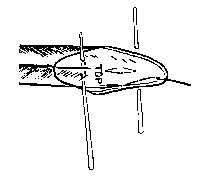Krippled Herring
Rigging Krippled Herring (5 to 10 Inch Baitfish)
 Figure 1
Figure 1To bait a Krippled Herring, slide the plastic head approximately 6 inches up the leader, away from the hook(s). Insert the bait snugly into the plastic head cavity, making sure the back of the bait is on the same side as the leader exit hole on the nose.
Once the bait is fully seated into the head cavity, impale it with a dry toothpick (Fig. 1). Push the toothpick until snug, then break the ends off cleanly and flush with the plastic head.
While supporting the baitfish, insert the hook into the side of the bait. Enter the hook just below the rear of the dorsal fin. The best action is achieved if the hook is placed where the silver meets the blue—several inches up from the tail (Fig. 2). The shank of the hook should lie flat against the bait. In a tandem rig, the rear hook should hang free at the side of the bait.
 Figure 2
Figure 2With the hook in place, carefully mold a slight curve in the baitfish, always curving it toward the hook side. The back of the bait should face you as you do this. To hold the curve in place, gently pull up the slack in the leader between the hook and the friction blister. Hold the plastic head in one hand and pull the leader with the other until the curve is maintained (Fig. 2 & 3).
 Figure 3
Figure 3To maintain friction and prevent slippage, replace the toothpick point in the blister as needed. If the leader begins to slip and won’t hold the curve, push a dry toothpick into the blister hole, forcing out the worn one. Push until snug and break the end off cleanly (Fig. 4).
 Figure 4
Figure 4Tips for Best Performance
- Always use firm, straight, bright bait, kept moist and cold.
- Troll at speeds of 2–3 knots, with bait revolutions of 1–2 per second.
- The desired action is a moderately slow spiral roll.
- If using a dodger or flasher, choose one at least 11 inches in length.
- Always sharpen your hooks—and keep them sharp.
- Always test your rigged bait for proper action alongside the boat before fishing.

